Imagination transforms wasted space in "Re-Create Taipei"
By Carol Hsieh
STAFF WRITER
Late summer is seeing more colors and smiles in Taipei this year because a communal push to transform deserted public spaces has sparked inspiration to liven up parks citywide. Local design team City Yeast collaborated with Madrid-based Basurama on the "Re-Creating Taipei" initiative that turned unwanted public equipment on two small, fragmented, and unused plots of city land into the Kids Ambition Park and Civil Swings Experimental Base, as a project for the World Design Capital (WDC) Taipei 2016.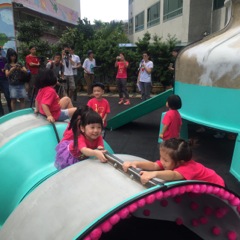
Many vacant lots still remain in Taipei, said Beatrice Hsieh, commissioner of the Taipei City Department of Cultural Affairs (DOCA) at the opening of the two sites on August 10. Hsieh hopes that this initiative, which saw collaboration between Taiwanese and international participants, will show the public that the WDC means more than just creation and novelty. It can also mean improvement and renovation of the old and worn-out, or re-purposing of the obsolete, as with "Re-Creating Taipei".
Two small vacant lots were chosen as test sites for the project. One of them, now home to the Kids Ambition Park, is located next to the Zhengyi Public Housing on the bustling Section 3 of Zhongxiao East Road. Right beside the lot is the non-profit Zhengyi kindergarten that takes in children living in and around the massive public housing complex, makingit the ideal site for a playground. Worn-out, disused water tanks of various sizes were cutup, combined with discarded recreational equipment, and turned into slides, a ball pool, a small, pink pompom-decorated tunnel that children can climb on and crawl through, and a couple of other features for them to wander about. Materials of different textures were affixed to some interior walls for children to touch, feel, and explore.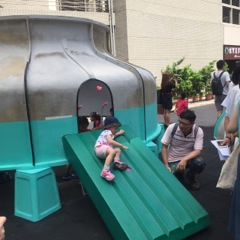
The second test site is home to the Civil Swings Experimental Base and is located under the elevated Civic Boulevard Expressway, an area that used to be dark, unwelcoming, and forgettable, like many other spaces under overpasses across the city. Work teams collected disused streetlamp poles provided by the Parks and Street Lights Office and carefully dismantled them, before welding them together and repainting them, repurposing them as tall, large swings with flattened old tires for seats. The swings are large and comfortable enough to accommodate both adults and children . Next to the swings are benches also made from streetlamp poles. The equipment is painted bright yellow, an idea the designers thought up specifically to attract the attention of passersby and brighten up an area that is in shade all daylong.
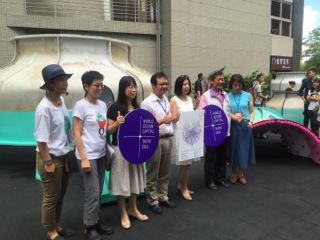
This initiative repurposes waste materials for public spaces and engages community participation, which completely revolutionizes the idea of the park, says DOCA. According to Huang Li-Yuan, director of the Parks and Street Lights Office, Taipei has 788 parks, 373 of which are small and scattered around the city’s packed neighborhoods. A 2016 budget of NT$18 million (US$580,000) was allocated to the transformation of such "neighborhood parks", in the hope not only of producing more innovative park apparatus suitable for parents to use with their children, but also of achieving that goal using a wide range of green and recycled materials.
Director of City Yeast Agua Chou believes that the Taiwanese public are fixated on the idea of safety and believe falsely that better playgrounds only means safer playgrounds. "The outdated, monotonous, standardized parks in Taiwan show that we have stopped movingforward. Safety has become the dominant index in construction, and as a result of such viewpoints, false beliefs and misguided behaviors have inhibited the flourishing of creativity and limited people’sexperience," Chou said in a statement to the press. 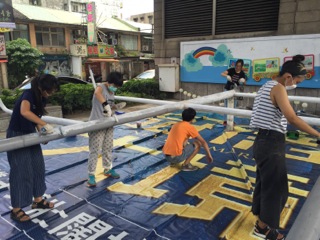
Chou thinks that both local government and the public need to think about why many neighborhoods parks are unattractive and only contain boring equipment like plastic slide-and-swing sets. The initiative is currently in its test phase, when inspirational ideas are being promoted and official and public responses taken into consideration. She hopes the experimental parks will teach people not to focus too much onthe safety of the equipment itself, but instead become more aware of how to play more safely and enjoyably. There are high hopes for the initiative in terms of opening up new possibilities in how people use public spaces, how they interact in such spaces, how we use recycled resources, and how can we develop unconventional public playgrounds in the future.
The Madrid design team Basurama, whose name is a composite of the Spanish words for "trash" and "love", consists of architects and artists known for their stunning creations from recycled materials that transform deserted public spaces into purposeful lands of color and fun. Since 2001, the team has completed 120 projects in 40 countries. "Re-create Taipei" is not the first time the non-profit organization has participated in the WDC. In 2014, for WDC Cape Town, the artists produced a large installation from plastic trash bags in the hope of raising awareness about sea pollution. On their trips to Taipei, the team saw the huge water tanks on the roof of almost every building here and thought them unique,because they are not a common sight in Europe. Thus, they decided to take that skyline and recreate it on the ground at the Kids Ambition Park. 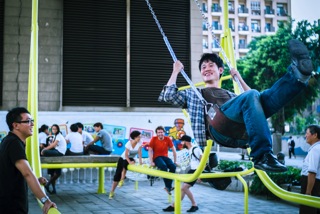
To attract participation from the international design community and extend its global influence, the WDC Taipei 2016 made an open call for proposals to bring international teams to join forces with local counterparts and carry out a series of carefully designed projects in Taipei over the year. Of the 49 proposals from 19 countries, six were selected,including "Re-Create Taipei".
The two experimental parks will be open all day, every day, until the end of October. For more information, please visit http://wdc2016.taipei/en/ or the initiative’s official Facebook page at https://www.facebook.com/citypark2016/?rc=p.

![Taiwan.gov.tw [ open a new window]](/images/egov.png)
